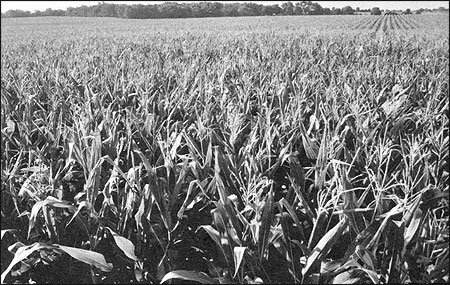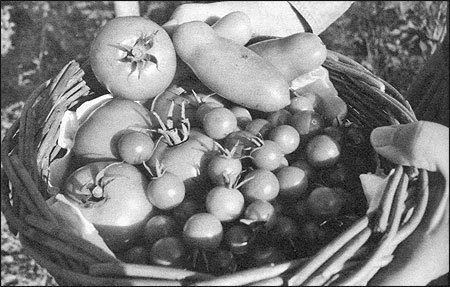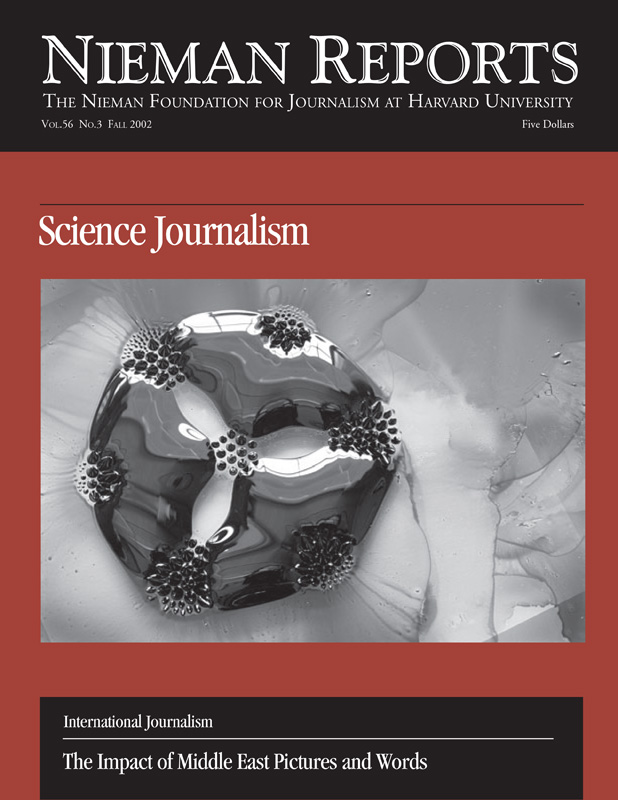
An Iowa field packed with corn plants reflects the intensity of modern farming. Scientific discoveries have made it possible to use corn and other crops as vehicles for producing all sorts of products, including pharmaceuticals. Photo by Anne Fitzgerald.
Every spring, P.W. Maher planted corn with precision, dropping seed so he could row the crop two ways—from one end of the field to the other and from side to side. Come fall, he would select the best ears for the next year’s seed. Tying them together with husks, two at a time, he would hang ears of corn on nails pounded into the crossbeams of a farm building, high overhead and well out of raccoons’ reach.
Farming in Iowa was like that a century ago: simple, slow, precise. Before hybridization and mechanization, it was also an act of faith. You plowed, planted and prayed for a good crop. Science, meaning nature, was left to work its magic. Harnessing it meant watching the sky, reading the Farmer’s Almanac, and keeping your fingers crossed. In those days, people produced much of their own food—gardening, canning, butchering and baking—or at least bought locally, making do with what the land allowed.
Producers now practice precision farming, employing Global Positioning System (GPS), biotechnology and spreadsheets. Consumers—short on time and full of demands—expect high-quality food that is safe, convenient and cheap.
Food today is a far cry from the farm-fresh produce of generations past. From top to bottom, scientific discoveries are revolutionizing the food chain. While much of the world’s food still is grown on a small scale and consumed locally, increasingly food production is a science-based business controlled by massive, multinational corporations racing to unlock the genetic secrets of plants and animals and to control their discoveries by patenting them.
Readers wonder what this means about the food they eat. They want to know what’s in their food and whether it is safe. They want to know about changes in the food chain, but they want someone else to sort out the science. They want reliable, unbiased information about what they eat and drink. They expect journalists to provide this information and explain how the genetic revolution is affecting food production and processing.
Why, then, in this age of biology, do news organizations give science such short shrift, or worse, get it wrong?
Certainly, science can be complicated, technical and difficult to understand, particularly for journalists more schooled in sentence structure, sequence of tenses, and the public’s right to know than functional genomics and the differences between DNA and RNA. Also, science stories take time to develop and are hard to photograph— two drawbacks in a business where quick, simple and scintillating sells. Of course, journalists reflect the general population in knowing little about science. But as science’s role in the food chain has grown, so has the need to report on it and to get it right.
The Knowledge Gap
Last year, during the outbreak of foot-and-mouth disease in the United Kingdom, there was a national debate over whether to vaccinate livestock against the highly contagious disease, rather than slaughtering thousands of animals that had shown no symptoms. Joe Brownlie, head of the infectious disease and pathology department at London’s Royal Veterinary College, said vaccinating cattle was not like vaccinating a dog, meaning that it would be more difficult and costly with a less certain outcome.
“Professor Brownlie says ‘No’ to vaccination” was posted on the BBC’s Web site. The professor said the headline didn’t capture his meaning. In fact, he found it misleading. “It’s a serious issue, because journalists are so powerful,” Brownlie said. “They shape perceptions, and no one’s ever held to account. No one ever does a postmortem.”
Later, after the UK had been declared free of foot-and-mouth disease, two sheep were found with antibodies to the virus. A reporter mistakenly took that to mean there was another outbreak of the disease. Brownlie explained that was not the case. So, the reporter persisted, how had the sheep caught the antibodies? Brownlie replied that animals don’t “catch” antibodies; they produce the specialized proteins to neutralize antigens, or foreign substances in the body.
“I am really very concerned about the gulf in scientific understanding among journalists. It is just monstrously bad,” Brownlie lamented one day last spring, sitting in his office, 20 miles north of London, surrounded by scientific texts, a collection of news clips from the foot-and-mouth disease crisis close at hand.
This British vet knows that the public generally does not understand science, and he believes journalists, similarly uninformed, are unwilling to educate themselves. “The public would rather a simple lie than a complex truth,” he says, citing Alexis de Tocqueville. “It seems to me that’s where we are, and I don’t know how we get over it.”
His lament is common. Food and agricultural experts—and not just sci-entists—often complain about how badly reporters botch scientific information. What can we do about this? How can we do science justice and get it right, while winning readers?
Start with something ordinary, like breakfast—cereal produced from genetically engineered crops; berries, bananas and peaches, likely treated with pesticides, and milk from cows injected with synthetic growth hormones and fed transgenic grain. Next up—crops engineered to deliver pharmaceuticals, from insulin to contraceptives, crops in which science, health and medicine merge.
It is essential for journalists to realize that factors fueling changes in the food chain—the pace, the depth and breadth of changes, the cost, the complexity and the controversy—all are linked somehow to science.
Science and Nature
Observe the world around us and see science at work. Take the corn growing just outside my kitchen window on 50 acres of gently rolling, rich black farmground that yields a sweet scent with the spring thaw. In mid-April, a huge tractor costing as much as a house pulls into the field. In P.W. Maher’s time, it would have taken a farmer with a team of horses several days to plant the field; today, it takes but a few hours, even though thousands more seeds are planted per acre.
No scientific advances, however, can correct the unusually cool, wet weather. Luckily, the farmers planted ahead of the rains and used seed corn capable of sitting in the ground for weeks until soil warmth triggers germination. By the Fourth of July, corn that a generation ago would have been knee high is head high. Our biennial privacy fence of dark green, leafy corn is in place for a summer of grilling and late-night stargazing.
Although I grew up on a central Iowa farm, I cannot describe in detail what it is that makes plants do what they do, much less the ways in which plants are being transformed into factories for human and animal pharmaceuticals.
I decide to get a closer look at science in action and plow my own ground, planting two dozen tomato plants that sit in soil for weeks, stalled by cool, wet weather. In May, the plants perk up one day, only to droop and wither the next, victims of a late spring frost. I plant again, doubling the count, assuming a 50 percent survival rate. Wrong again. By mid-summer, tomatoes have taken over the garden—a jumble of leafy vines. I plant lettuce seeds too tiny to be dropped one by one, as the package instructs, and get lanky lettuce because the plants are so crowded together. Then I open a package of radish seeds, which says that the seeds are patented, bringing me back to the genetic revolution.

Part art and part science, producing food requires patience and precision. Even then, the weather and other forces determine the outcome. Photo by Anne Fitzgerald.
Covering the Genetic Engineering Debate
In the mid-1990’s, U.S. farmers began planting soybeans genetically engineered to tolerate application of a popular herbicide called Roundup. Within just a few years, the majority of U.S. soybean acreage was planted with the biotech-based seed, and growers in countries such as Argentina were planting the seeds. Genetically engineered corn followed.
Critics believe the crops have the potential to harm the environment and human health. But proponents contend the crops are good for the environment, in part because they can reduce the need for pesticides and reduce risk of ground water contamination. Supporters also believe the crops are safe for human consumption. They argue that “sound science” should be the arbiter of regulatory wrangling and trade disputes, but what does that mean? Do they mean science that confirms their own views or scientific analysis free of emotional, fear-inducing claims? And how do we, as journalists, sort through increasingly complex and vociferous arguments to present reliable, current information to our readers?
A journalist’s job is to pursue the truth and inform the public. But if we don’t understand science well enough to know the hard questions to ask, then we risk giving readers misleading or erroneous information. We need to be on guard against both grandiose claims and unsubstantiated criticism. We need to know who pays for research and watch for conflicts of interest. We also need to be reading the literature—scientific journals, the mainstream press and alternative publications, both in print and online. And we need to be aware of the vast difference in attitudes toward food, agriculture and science. U.S. and European consumers, for instance, differ in their views of transgenic crops in the food chain—a difference with ramifications for farmers, processors, regulators, retailers and world trade.
Science is sometimes learned best by doing, so at every opportunity I get out of the office and into laboratories, fields and food processing plants to talk with those actually making scientific discoveries and applying them. I also talk to those who shun souped-up science and to consumers who increasingly drive decisions in the food chain. Many Saturday mornings during the growing season, I roam the downtown Des Moines farmers’ market, one of the biggest in the country. I note consumers’ comments and visit with growers who produce food the old-fashioned way—simply, slowly, precisely.
Before dawn on 26 consecutive Saturdays, from mid-May through October, Cindy Madsen leaves her farmstead in Audubon County and drives 80 miles to the market where she sells free-range eggs, antibiotic-free pork, and other farm-fresh foods. By mid-morning, she sells out of some products. So do Neil Sauke, who bakes bread for a living, and Larry Cleverley, who grows lettuce, garlic and beans. Last spring, Cleverley struggled to raise a lettuce crop, victimized by extremes in weather. I have had no such trouble, every few days harvesting a bundle.
Into late summer, I am washing lettuce left to grow tall and tart. Leaf by leaf, I remove soil and sorry edges, watch various shades of green emerge, marvel at how seeds so tiny as to be almost imperceptible, plunked into soggy, springtime soil, now yield luscious growth bursting with vitamins and nutrients and promising more of the same until the first frost.
Like P.W. Maher, my grandfather, I take my time, noting color and taste and texture, wondering what pests have perforated leaves, quietly enjoying what nature has wrought. Or was it science? If we want more readers, we have to be credible. With science, that just might take dirt under the nails.
Anne Fitzgerald, a 2001 Nieman Fellow, is agribusiness writer for The Des Moines Register.


